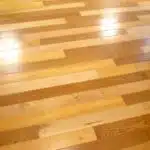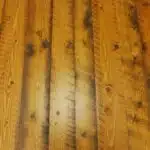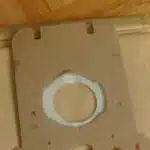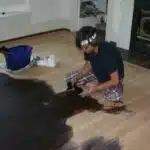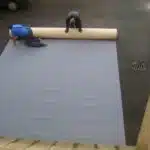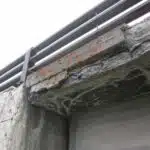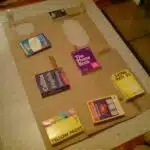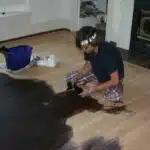As a floor cleaning expert, I understand the importance of maintaining a clean and hygienic living space. A properly cleaned floor not only enhances the overall look of your home but also creates a healthy environment for you and your loved ones. However, with so many flooring materials available in the market, it can be challenging to determine the best way to clean them.
In this article, I will guide you on how to clean your floors effectively, regardless of their material. From hardwood and tile to carpet and laminate, I will provide you with tips and tricks that will leave your floors spotless and germ-free. Whether you are a homeowner or a commercial property owner, these cleaning techniques will help you achieve a clean and welcoming space for yourself or your guests. So let’s dive in and discover the secrets to maintaining pristine floors!
Preparing Your Cleaning Supplies
Choosing appropriate, eco-friendly cleaning supplies is crucial before starting to clean a floor. It is important to use cleaning products that are safe for the environment and also effective in removing dirt and grime. When selecting your cleaning supplies, check the labels to ensure that they are free of harmful chemicals and toxins.
Organizing cleaning supplies for easy access and efficiency is another important step before beginning the cleaning process. Make sure all necessary equipment such as mops, brooms, buckets, and cleaning solutions are easily accessible. This will save you time and energy during the actual cleaning process.
In addition, it is important to have a designated storage area for your cleaning supplies. This will prevent clutter and confusion when it comes time to clean your floors. By keeping everything organized and in its place, you can quickly grab what you need and get started with the task at hand. With these two steps completed, you are now ready to move on to removing debris and loose dirt from your floors.
Removing Debris And Loose Dirt
To effectively clean a floor, it is essential to first remove any debris or loose dirt that may be present. This can be achieved using a variety of cleaning tools, depending on the type of debris that needs to be removed. Using a broom is an effective method for larger debris, such as leaves or twigs, while smaller particles like dust and crumbs can be easily removed with a vacuum.
When using a broom for removing debris, it is important to choose the right tool for the job. A stiff-bristled broom works best for outdoor floors or rough surfaces like concrete or brick, while a soft-bristled broom is more suited for indoor floors made of wood or tile. Vacuuming is also an effective way to remove loose dirt from floors. It is important to choose the appropriate suction power based on the type of flooring you are cleaning.
Different types of debris require different cleaning methods. For example, sticky substances like gum or wax can be removed with ice cubes placed over them until they harden and then chipped away gently with a plastic scraper. Grease stains can be cleaned by applying baking soda mixed with water and scrubbing with a brush. Knowing the right cleaning method for specific types of debris will make your floor cleaning process more efficient.
Different types of dirt also require different cleaning methods. For instance, mud stains can be cleaned by allowing them to dry before scraping off excess mud and then scrubbing with soap and water. Pet hair can be removed by using a rubber squeegee on carpeted floors. Understanding how to clean various types of dirt will help you achieve optimal results when maintaining your floors.
To continue cleaning your floor effectively after removing debris and loose dirt, sweeping or vacuuming the floor surface is necessary before moving onto other cleaning steps.
Sweeping Or Vacuuming The Floor Surface
Sweeping or vacuuming the floor surface is an essential first step in cleaning any room. The benefits of sweeping or vacuuming your floors regularly are numerous, including preventing dirt and dust buildup, reducing allergens, and maintaining the appearance of your flooring. Sweeping also allows you to get into tight corners that a vacuum may not reach.
When selecting the right tools for sweeping or vacuuming your floors, there are several factors to consider. For instance, if you have hardwood floors, a soft-bristled broom is ideal because it won’t scratch the surface. If you have carpeted floors, a vacuum with a rotating brush can help loosen dirt and debris from the fibers. Additionally, when using a broom or vacuum cleaner, it’s important to use proper technique so that you don’t damage your flooring.
Vacuuming techniques vary depending on the type of flooring in your home. For example, when vacuuming hardwood floors, be sure to turn off the rotating brush attachment to prevent scratching. On the other hand, when vacuuming carpets, use slow back-and-forth motions to thoroughly clean each section of carpet. By following these tips and selecting the right tools for your specific flooring type, sweeping or vacuuming can become an easy task that will keep your home looking clean and inviting.
Transition: Now that we’ve covered the benefits of sweeping or vacuuming and how to select the right tools for this task let’s move on to mopping hardwood floors.
Mopping Hardwood Floors
Did you know that hardwood floors are the most popular type of flooring in the United States? In fact, according to a recent survey, approximately 54% of American homes have some type of hardwood flooring installed. This means that knowing the best mopping techniques and choosing the right cleaning solution is essential to maintaining their beauty and longevity.
To start off with the best mopping technique, always use a damp mop instead of a wet one. A wet mop can cause water damage to your hardwood floors, which can lead to warping or buckling. Also, avoid using too much cleaning solution as it can leave a residue on your floors and make them look dull over time. Instead, use just enough cleaning solution to get the job done.
Choosing the right cleaning solution for your hardwood floors is crucial as well. Avoid using vinegar or acidic cleaners as they can damage the finish on your floors. Instead, opt for a pH-neutral cleaner specifically designed for hardwood floors. Always read the label carefully and follow the manufacturer’s instructions for dilution and usage. By following these tips, you’ll be able to keep your hardwood floors looking beautiful for years to come.
When it comes to cleaning tile and grout, there are several things you need to keep in mind. First of all, always wear gloves and protective eyewear when working with harsh chemicals like bleach or ammonia-based cleaners. Second, start by sweeping or vacuuming up any loose debris from your tile floor before applying any cleaning solutions. Finally, use a scrub brush or toothbrush to work the cleaner into grout lines and other hard-to-reach areas before rinsing thoroughly with warm water. Remember that regular maintenance is key when it comes to keeping your tile and grout looking clean and fresh!
Cleaning Tile And Grout
Cleaning tile and grout can be a daunting task, but it is essential to maintain the appearance and hygiene of your floor. One of the most effective ways to clean tile and grout is through steam cleaning. Steam cleaning utilizes high-temperature water vapor to loosen dirt and grime from the surface of the floor, making it easier to clean.
However, after steam cleaning, it is crucial to seal your grout lines. Grout sealing helps prevent dirt and stains from penetrating into the porous material, which can lead to discoloration or mold growth over time. Applying a sealer can also make future cleaning easier by providing a protective layer on top of the grout.
In summary, steam cleaning followed by grout sealing is an effective way to clean tile floors. It is essential to follow these steps regularly to maintain the appearance and hygiene of your floor. By doing so, you will not only have a beautiful-looking floor but also ensure that you are living in a safe and healthy environment for yourself and others.
| Emotion evoking table | Cleaning Tile & Grout |
|---|---|
| Frustration | Cleaning tile & grout can be overwhelming at times due to its porous nature |
| Satisfaction | Steam cleaning provides an efficient way to remove tough stains & grime from tiles |
| Relief | Grout sealing helps prevent future dirt & stains from ruining your hard work |
Moving onto deep cleaning carpets, another significant aspect of maintaining your home’s cleanliness involves taking care of your carpets. Carpets tend to accumulate dirt and dust over time, especially when exposed frequently to foot traffic or pets. In the next section, we will discuss some tips on how you can deep clean carpets effectively without causing any damage or discoloration.
Deep Cleaning Carpets
How often do you deep clean your carpets? While regular vacuuming can remove surface dirt and debris, it doesn’t address the deep-seated stains and bacteria that accumulate over time. To fully refresh and sanitize your carpets, consider steam cleaning.
Steam cleaning is a highly effective method for removing dirt, grime, and allergens from your carpets. This process involves using hot water and a specialized solution to break down tough stains and extract them from the fibers of your carpet. Unlike traditional shampooing methods, steam cleaning penetrates deeper into the carpet pile, providing a more thorough clean.
If you’re not comfortable tackling this task yourself, there are professional services available that can handle the job for you. These companies have specialized equipment and training to ensure your carpets are cleaned safely and effectively. Plus, by opting for a professional service, you can save yourself time and hassle while achieving optimal results.
Here are four reasons why investing in deep carpet cleaning is worth it:
- Improved indoor air quality: Dirty carpets can harbor dust mites, pet dander, and other allergens that circulate through the air when disturbed.
- Extends carpet lifespan: Regular deep cleaning can help prevent wear and tear on your carpets by removing abrasive dirt particles.
- Removes stubborn stains: Professional equipment can tackle even the toughest stains like red wine or grease.
- Better overall appearance: Clean carpets look brighter and fresher than dirty ones.
With steam cleaning or professional services at your disposal, there’s no excuse for living with dingy or stained carpets. By investing in regular deep cleans, you’ll not only improve the aesthetic appeal of your home but also promote a healthier living environment. In the next section, we’ll discuss how to spot clean stains as they happen to avoid long-term damage to your flooring.
Spot Cleaning Stains
Spot Cleaning Stains:
While regular maintenance can help prevent most stains from setting in, accidents still happen. When this occurs, it is important to act fast and clean up the stain as soon as possible. Failure to do so may result in a permanent stain that will require professional cleaning services.
To remove common stains such as coffee or wine, using household items like white vinegar or baking soda can be effective. Simply mix the vinegar or baking soda with warm water and apply it to the affected area with a cloth or mop. Allow the solution to sit for 5-10 minutes before rinsing thoroughly with clean water. For tougher stains like ink or oil, a commercial cleaner may be necessary. Be sure to follow the manufacturer’s instructions carefully and test the product on an inconspicuous area before applying it to the entire stain.
If all else fails, it may be time to call in professional cleaning services. They have access to specialized equipment and cleaning agents that can effectively remove even the toughest of stains without damaging your flooring. Additionally, they can provide advice on how best to maintain your floors going forward so that you can avoid future mishaps.
Transitioning into Maintaining Laminate Flooring:
Now that you know how to spot clean stains on your laminate flooring, it’s important to also learn how to maintain its overall appearance and longevity over time. This includes regular sweeping and mopping as well as avoiding harsh chemicals that could damage its protective coating. Let’s take a closer look at some tips for maintaining laminate flooring in our next section.
Maintaining Laminate Flooring
After spot cleaning stains from your floor, it’s essential to maintain the overall cleanliness of your laminate flooring. Choosing laminate as your floor material has some benefits, including its durability and affordability. However, preventing damage is crucial to ensure that it lasts for a long time.
Here are three things you can do to maintain the quality of your laminate flooring:
Sweep or vacuum regularly – Dust and dirt can quickly accumulate on your floor if left unattended. Regular sweeping or vacuuming can help reduce the amount of debris that accumulates on the surface.
Use a damp mop – When mopping your floor, make sure to use a damp mop instead of a wet one. Too much water can cause damage to your laminate flooring by seeping through the seams and causing swelling.
Avoid harsh chemicals – While it may be tempting to use strong chemicals to clean tough stains, these substances can cause more harm than good. They can strip away the protective layers of your flooring and leave it vulnerable to scratches and other forms of damage.
Preventing damage is key when caring for your laminate floors. By following these simple steps, you can keep them looking great for years to come. In the next section, we will discuss how you can care for vinyl floors in a similar manner without damaging them in any way.
Caring For Vinyl Floors
When it comes to maintaining the look of your vinyl floors, preventing scratches is key. While vinyl is a durable material, it can still be easily damaged by sharp objects or heavy furniture. To prevent scratches, avoid dragging furniture across the floor and use felt pads under chair legs and table feet. Additionally, place doormats at entrances to reduce the amount of dirt and debris that can scratch your floors.
Choosing the right cleaning solution for your vinyl floors is also important. Harsh chemicals and abrasive cleaners can damage the finish and cause discoloration over time. Instead, opt for a pH-neutral cleaner specifically designed for vinyl flooring. Dilute the cleaner in water according to the manufacturer’s instructions and mop the floors regularly to keep them looking their best.
In summary, taking care of your vinyl floors involves preventing scratches and choosing appropriate cleaning solutions. By following these simple steps, you can keep your floors looking great for years to come. In the next section, we will discuss how to polish and buff hardwood floors to restore their natural shine.
Polishing And Buffing Hardwood Floors
To achieve a polished and buffed look on hardwood floors, there are certain techniques that need to be followed. First and foremost is choosing the right products. It is important to select a high-quality floor polish that is specifically designed for hardwood floors. Furthermore, make sure it does not contain harsh chemicals that could damage the wood’s natural finish.
When it comes to DIY floor polishing techniques, there are several options available. One method involves using a floor buffer with a soft pad attachment. This will help to evenly distribute the polish across the surface of the floor. Alternatively, you can use a microfiber mop or cloth to apply the polish manually. Whichever method you choose, make sure to work in small sections and avoid leaving excess polish on the floor.
Overall, achieving a polished and buffed look on hardwood floors requires patience and attention to detail. By choosing the right products and using effective DIY techniques, you can transform your dull-looking hardwood floors into a stunning feature of your home.
Moving onto cleaning stone floors, it is important to note that they require different care compared to other types of flooring materials. Stone floors should never be cleaned with acidic or abrasive cleaners as they can cause irreversible damage. Instead, opt for gentle cleaning solutions specifically designed for stone surfaces.
Cleaning Stone Floors
Maintaining stone floors is essential for keeping them looking their best. Proper care and attention will ensure that they remain in pristine condition for years to come. One of the most critical aspects of maintaining stone floors is choosing the right cleaning products. Using the wrong cleaning products can cause damage and discoloration, so it’s important to choose a product that’s specifically formulated for use on stone floors.
When choosing a cleaning product, look for something that’s pH neutral or slightly acidic. Avoid using alkaline cleaners, as they can weaken the surface of your stone floor over time. Additionally, try to avoid using abrasive cleaners, such as those containing bleach or ammonia as these can scratch or dull your floor’s surface.
To clean your stone floor effectively, follow these simple steps:
- Sweep or vacuum up any loose debris.
- Dilute your chosen cleaning product according to the manufacturer’s instructions.
- Mop the solution onto your floor and allow it to sit for a few minutes.
- Rinse thoroughly with water and allow the floor to air dry.
By following these steps and using the right products, you’ll be able to keep your stone floors looking their best for years to come. However, if you have concrete floors in need of treatment, there are some additional steps you should take to ensure they’re properly maintained.
Treating Concrete Floors
If you have a concrete floor, it is essential to keep it clean and well-maintained. Cleaning your concrete floor regularly will help protect it from damage, keep it looking its best, and ensure that it lasts for many years to come. In addition to regular cleaning, treating your concrete floor with a sealant can provide an extra layer of protection against stains and damage.
Sealing concrete floors is a crucial step in maintaining their integrity. Concrete is porous and can easily absorb liquids like water, oil, or other substances. When left unsealed, these liquids can penetrate the surface of the concrete, causing stains and damage over time. Sealing your concrete floor can help prevent this from happening by creating a barrier between the surface of the concrete and any liquids that may come into contact with it.
Removing oil stains from your concrete floor can be challenging but not impossible. The first step is to blot up as much of the oil as possible using paper towels or rags. Next, sprinkle baking soda or cornstarch over the stain and let it sit for at least 30 minutes. After that, sweep or vacuum up the powder and use a scrub brush to gently scrub the stain with warm soapy water. Rinse thoroughly with clean water and repeat if necessary until the stain is completely gone.
Transitioning into removing pet hair and dander: Now that you know how to treat your concrete floors properly let’s move on to another common problem – pet hair and dander on floors. Pets are lovely companions but leave behind unwanted dirt which requires special cleaning techniques.
Removing Pet Hair And Dander
When it comes to cleaning floors, pet hair and dander can be one of the most challenging issues to deal with. One way to prevent this problem is through regular pet grooming. Brushing your pet’s fur regularly can reduce shedding, which means less hair on your floor. Additionally, bathing your furry friend can help remove excess dander that gets trapped in their fur.
Another solution to combat pet hair and dander on your floors is by using air purifiers. These devices work by trapping allergens and other particles in the air, including pet hair and dander. By running an air purifier in the room where your pets spend most of their time, you can improve air quality and reduce the amount of hair and dander that ends up on your floors.
However, even with preventative measures like pet grooming and air purifiers, there will still be some pet hair and dander on your floors. To remove these unwanted particles effectively, consider using a vacuum cleaner specifically designed for removing pet hair or a microfiber mop that traps dust instead of spreading it around. By incorporating these methods into your floor cleaning routine, you’ll have a more hygienic living space for both you and your beloved pets.
Incorporating these solutions into your cleaning routine will make a significant impact on reducing the amount of pet hair and dander that accumulates on your floors. However, if you’re looking for an even more eco-friendly approach to floor cleaning, consider exploring green cleaning products that are free from harsh chemicals and environmentally harmful ingredients. In the next section, we’ll explore some eco-friendly solutions for keeping your floors clean without harming our planet’s precious resources.
Green Cleaning And Eco-Friendly Solutions
As an expert in floor cleaning, it is my duty to recommend eco-friendly floor cleaners and sustainable cleaning practices. Imagine a world where every household and business adopted this approach – a world where our environment was respected and preserved. Eco-friendly floor cleaners are biodegradable and free from harmful chemicals, making them safe for both humans and pets. They also come in recyclable packaging, reducing waste that would otherwise end up in landfills.
If you’re looking to make the switch to eco-friendly floor cleaners, here are four options to consider:
- Vinegar: Mix equal parts of vinegar and water for a natural solution that’s effective on hardwood floors.
- Baking soda: Combine 1/2 cup baking soda with warm water for a gentle yet efficient cleaner.
- Castile soap: Made from olive oil, castile soap is ideal for all types of flooring.
- Lemon juice: Add lemon juice to your mixture of water and vinegar or baking soda for an extra boost of cleaning power.
By adopting sustainable cleaning practices like using eco-friendly floor cleaners, we can reduce our carbon footprint and protect our planet’s resources for future generations. It may seem like a small step, but it can make a big difference in the long run.
As we strive towards a greener future through eco-friendly floor cleaners and sustainable cleaning practices, we must also keep safety precautions in mind while cleaning floors. By taking simple steps such as wearing gloves, keeping children and pets away from the area being cleaned, and ensuring proper ventilation during use of any cleaning product, we can ensure that our homes or businesses are clean without compromising on safety.
Safety Precautions While Cleaning Floors
When it comes to cleaning floors, safety should always be a top priority. It is important to take proper precautions to avoid accidents and injuries during the cleaning process. One of the most crucial aspects of floor cleaning safety is ensuring proper ventilation in the area. This helps to prevent the buildup of harmful fumes and chemicals that can cause respiratory problems for those who are exposed to them.
In addition to ventilation, it is also essential to use cleaning chemicals properly. Always read and follow the instructions on the label carefully before using any product. Be sure to wear protective gear such as gloves, goggles, and a mask if necessary. Keep all cleaning chemicals out of reach of children and pets, and never mix different products together as this can create dangerous chemical reactions.
By taking these safety precautions seriously, you can ensure a safe and effective floor cleaning experience every time. Remember that accidents can happen even when you are being careful, so be prepared with a first aid kit on hand just in case. With these tips in mind, you can clean your floors with confidence knowing that you are doing so safely and responsibly.
Conclusion
Cleaning your floors is an essential task that helps maintain a healthy and hygienic environment in your home or workplace. To ensure effective cleaning, you need to prepare the right cleaning supplies, remove debris and loose dirt, sweep or vacuum the floor surface, mop hardwood floors, clean tile and grout, treat concrete floors, and remove pet hair and dander. Additionally, using eco-friendly solutions can help reduce environmental impact while keeping your floors clean.
According to a recent survey by The American Cleaning Institute (ACI), 91% of Americans believe that having a clean home is essential for their mental health and wellbeing. Moreover, 57% of people said that they feel relaxed when their home is clean. This highlights the importance of maintaining a clean living space and how it can positively impact our mental health.
As a floor cleaning expert, I recommend taking necessary safety precautions while cleaning floors to avoid accidents. Ensure proper ventilation when using chemicals or cleaning products with strong odors. Wear gloves and protective clothing if required for certain cleaning tasks. Remember to follow manufacturer instructions for cleaning products and equipment to ensure optimal results.
In conclusion, following the steps outlined in this article will help you achieve a spotless floor while maintaining good hygiene standards in your home or workplace. By implementing green cleaning practices and being mindful of safety precautions, you can ensure that your floors remain clean while reducing environmental impact. Remember that cleanliness not only contributes to physical health but also promotes mental wellbeing by creating a relaxing living space.
Image Credits
- “ebony stain on oak floors how-to (read this first: i.e. our floor nightmare)” by ninahale (featured)


